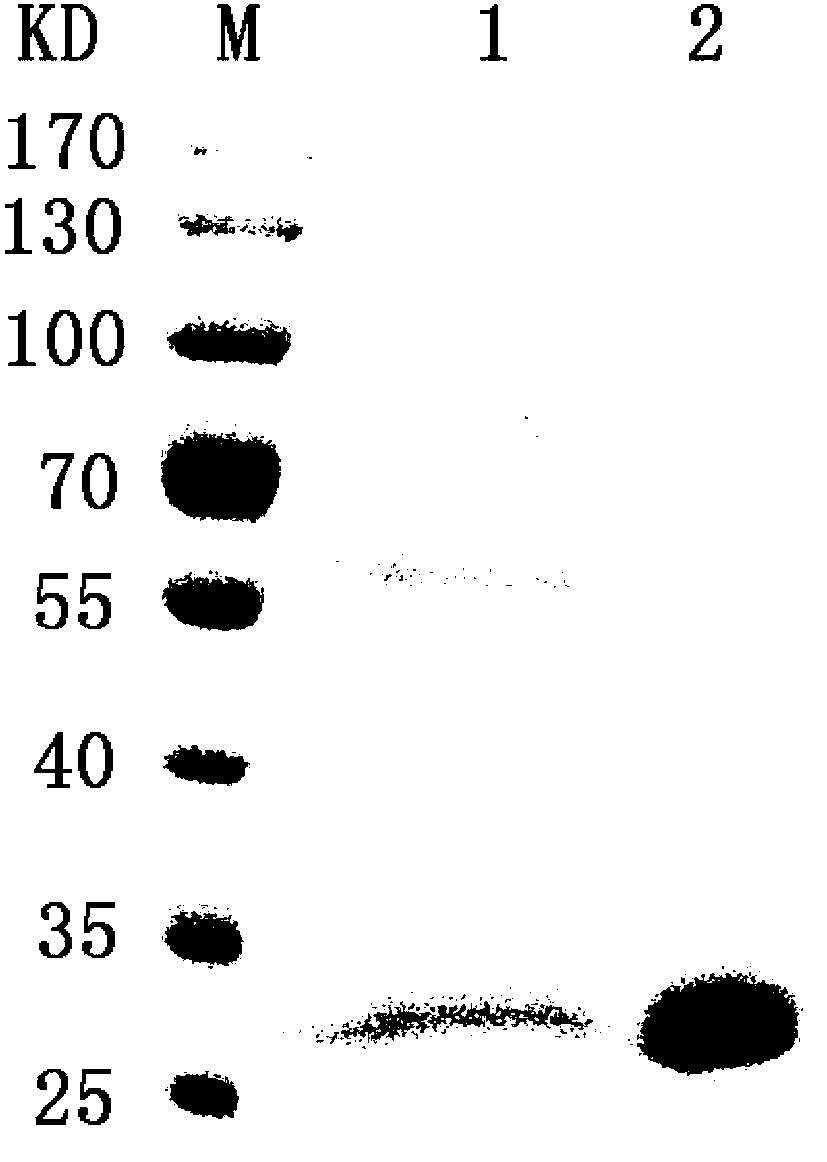Aspergillus bacterial strain and endo-chitosan enzyme CsnW2 encoding gene, preparation method and application thereof
A technology of Aspergillus and glycanase, which is applied in application, genetic engineering, plant genetic improvement and other directions, can solve the problems of poor homology of chitosanase, no reports on cloning and expression, and few studies, and achieve large-scale production. Effects of potential and economic value
- Summary
- Abstract
- Description
- Claims
- Application Information
AI Technical Summary
Problems solved by technology
Method used
Image
Examples
Embodiment 1
[0081] The cultivation of embodiment 1 Aspergillus clavatus W-2 and the production of chitosanase
[0082] The strain used was Aspergillus clavatus, and a single clone of the Aspergillus clavatus W-2 strain (CGMCC NO.7018) was picked and inoculated into 30ml liquid medium, and then cultured on a shaker with a temperature of 30°C and a rotation speed of 150rpmin After 4 days, the culture solution was centrifuged to collect the supernatant medium.
[0083] The liquid medium formula used is (g / L): chitosan 5.0g, yeast extract powder 0.5g, NaCl0.5g, MgSO4 7H2O1.44g, CaCl20.1g, KCl0.5g, K2HPO42.0g, KH2PO41.0g , the pH value is 7.0, and the balance is water.
[0084] Definition of enzyme activity unit (U): the amount of enzyme required to catalyze chitosan to produce 1 μmol reducing sugar per minute. According to the DNS method, the enzyme activity in the liquid medium supernatant of Aspergillus clavatus W-2 strain was 0.53U / ml.
Embodiment 2A
[0085] The extraction of embodiment 2Aspergillus clavatus W-2 bacterial strain total RNA
[0086] The strain was cultured for 4 days, filtered with gauze, and the bacteria were directly stored in liquid nitrogen. Take about 40 mg of the thallus and grind it three times under liquid nitrogen. Then add 1ml Trizol reagent, and transfer to a 1.5ml centrifuge tube after melting. Add 200ul chloroform to the system, shake vigorously, let stand for 5min, and centrifuge at 12000rpm for 15min. Carefully take the supernatant into a new centrifuge tube, add an equal volume of isopropanol, let stand for 5 minutes, and centrifuge at 12,000 rpm for 10 minutes. Pour off the supernatant, add 1ml of ethanol with a volume concentration of 75% to the precipitate, and centrifuge at 7500rpm for 5min. Finally, dissolve the precipitate with 20-50ul of ribonuclease-free water. Store at -80°C for later use.
Embodiment 3
[0087] The cloning of embodiment 3csnW2 gene 3' end mRNA sequence
[0088]According to the operation steps in the manual of 3'-Full RACE Core Set Ver.2.0 (Takara Code: D314) of Takara Bioengineering (Dalian) Co., Ltd., the 3'RACEAdaptor was used as the primer, and the total RNA of Aspergillus clavatus W-2 strain was used as the template for reverse reaction. The first strand of cDNA was transcribed and synthesized; the first round of PCR was performed with 3'RACE Outer Primer (TACCGTCGTTCCACTAGTGATTT) and SP Primer (ATGGAYATCGACTGYGAYGG) as primers, and the reaction conditions were: 94°C for 3min, 30 cycles (94°C for 30sec, 55°C for 30sec, 72°C for 1.2min), 72°C for 10min; use 3'RACE Inner Primer (CGCGGATCCTACCGTCGTTCCACTAGTGATTTCACTATAGG) and SP Primer (ATGGAYATCGACTGYGAYGG) as primers for the second round of PCR, and the reaction conditions are: 94°C for 3min, 30 cycles (94°C ℃ 30sec, 58℃ 30sec, 72℃ 1.2min), 72℃ 10min. The two rounds of PCR products were analyzed by 1% agar...
PUM
 Login to View More
Login to View More Abstract
Description
Claims
Application Information
 Login to View More
Login to View More - R&D Engineer
- R&D Manager
- IP Professional
- Industry Leading Data Capabilities
- Powerful AI technology
- Patent DNA Extraction
Browse by: Latest US Patents, China's latest patents, Technical Efficacy Thesaurus, Application Domain, Technology Topic, Popular Technical Reports.
© 2024 PatSnap. All rights reserved.Legal|Privacy policy|Modern Slavery Act Transparency Statement|Sitemap|About US| Contact US: help@patsnap.com










